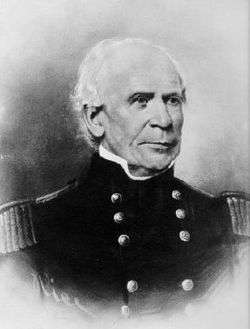Thomas Jesup
Thomas Sidney Jesup (December 16, 1788 – June 10, 1860) was a United States Army officer known as the "Father of the Modern Quartermaster Corps". His 52-year (1808–1860) military career was one of the longest in the history of the United States Army.
Thomas Sidney Jesup | |
|---|---|
 Brigadier General Thomas Sidney Jesup 13th quartermaster General of the United States Army | |
| Born | December 16, 1788 Berkeley County, Virginia (today West Virginia) |
| Died | June 10, 1860 (aged 71) Washington, D.C. |
| Resting Place | Oak Hill Cemetery Washington, D.C. |
| Allegiance | United States |
| Service/ | United States Army |
| Years of service | 1808–1860 |
| Rank | Brigadier General |
Biography
Thomas Jesup was born in Berkeley County, Virginia (now West Virginia). He began his military career in 1808, and served in the War of 1812, seeing action in the battles of Chippewa and Lundy's Lane in 1814, where he was wounded. He was appointed Quartermaster General on May 8, 1818, by President James Monroe.[1]
Seminole War and controversy
In 1836, while Jesup was still officially Quartermaster General, President Andrew Jackson detached him first to deal with the Creek tribe in Georgia and Alabama, and then to assume command of all U.S. troops in Florida during the Second Seminole War (1835–1842).[2] His capture of Seminole leaders Osceola and Micanopy under a false flag of truce [3] provoked controversy in the United States and abroad. [4] Many newspapers called for an inquiry and his firing but the government supported its general,[5] and at the conclusion of the hostilities, Jesup returned to his official post.[1] He was famously quoted as having declared about the Seminole that "[t]he country can be rid of them only by exterminating them."[6]
Further service
During the Mexican–American War, Jesup traveled from his headquarters in Washington, D.C., to oversee the supplying of troops in Mexico. He served as Quartermaster General for 42 years, having the second longest continual service in the same position in U.S. military history (George Gibson served as Commissary General of the US Army for 43 years, from 1818 until 1861).[7]
He died in office in Washington, D.C., in 1860 at age 71.[1]
Dates of rank
- 2nd Lieutenant, 7th Infantry – 3 May 1808
- 1st Lieutenant, 7th Infantry – 1 December 1809
- Captain, 7th Infantry – 20 January 1813
- Major, 19th Infantry – 6 April 1813
- Major, 25th Infantry – 18 April 1814
- Brevet Lieutenant Colonel – 5 July 1814
- Brevet Colonel – 25 July 1814
- Major, 1st Infantry – 17 May 1815
- Lieutenant Colonel, 3rd Infantry – 30 April 1817
- Colonel, Assistant Adjutant General – 27 March 1818
- Brigadier General, Quartermaster General – 8 May 1818
- Brevet Major General – 8 May 1828
Legacy and honors
- Jesup, Georgia; Lake Jesup, Florida; and Fort Jesup, Louisiana, were named in his honor.
- 1986, Jesup was inducted into the Quartermaster Hall of Fame.[1]
- Battery Jesup at the Spanish–American War fort, Fort Fremont[8][9]
References
- Brigadier General Jesup, father of the Quartermaster Corps Archived March 25, 2014, at the Wayback Machine, US Quartermaster Foundation
- Jahoda, Gloria. The Trail of Tears: The Story of the American Indian Removals 1813–1855. Holt, Rinehart and Winston. New York. 1975. ISBN 0-03-014871-5.
- United States. Congress. House. House Documents, Otherwise Publ. as Executive Documents: 13th Congress, 2d Session-49th Congress, 1st Session. p. 15.
- Patricia Riles Wickman (August 27, 2006). Osceola's Legacy. University of Alabama Press. p. 25. ISBN 978-0-8173-5332-2.
- Hatch, Thom (2012). Osceola and the Great Seminole War. New York: St. Martin’s Press. p. 219.
- Indigenous Peoples History (book cover), Roxanne Dunbar-Ortiz
- History, U.S. Army Center of Military. "The Subsistence Department – Center of Military History". History.army.mil. Retrieved November 11, 2017.
- "Fort Fremont Historical Park & Beach – History". Fortfremont.org. Retrieved November 11, 2017.
- "Fort Fremont – St. Helena Island, South Carolina". Sciway.net. Retrieved November 11, 2017.
External links
- "Thomas Jesup". Find a Grave. Retrieved May 26, 2009.
- Jesup, Thomas S. "Letter, 1836 Oct. 25, Headquarters, Apalachicola [to] W[illia]m Schley, Governor of Georgia, Milledgeville, Georgia / Major General T[homas] S. Jesup". Southeastern Native American Documents, 1730-1842. Hargrett Rare Book and Manuscript Library, The University of Georgia Libraries, Digital Library of Georgia. Retrieved February 21, 2018.
- Jesup, Thomas S. "Letter, 1836 Dec. 9, Volusia, Florida, [to] Governor W[illia]m Schley, Milledgeville, Georgia / T[homas] S. Jesup". Southeastern Native American Documents, 1730-1842. Hargrett Rare Book and Manuscript Library, The University of Georgia Libraries, Digital Library of Georgia. Retrieved February 21, 2018.
| Military offices | ||
|---|---|---|
| Preceded by George Gibson |
Quartermaster General of the United States Army 1818–1860 |
Succeeded by Joseph E. Johnston |